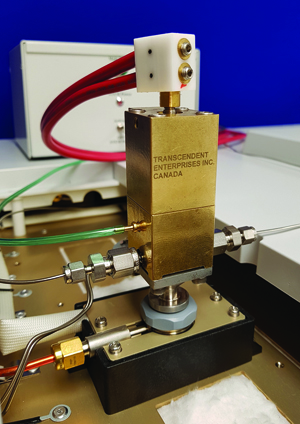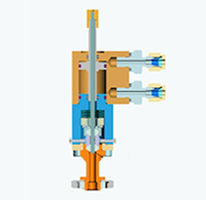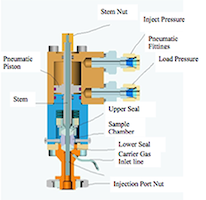HPLIS = Heated Pressurized Liquid Injection System
HSTEM = Heated Stem
 The HPLIS valve assembly is intended for the introduction of pressurized liquid samples containing very polar, high boiling or high carbon number analytes into on-Line, at-Line or laboratory based Gas Chromatographs equipped with Split/Splitless capillary inlets or direct to column connections. It has a reciprocating HSTEM with a machined groove (heated) at its lower extremity designed to contain the pressurized liquid sample to be analyzed. The HSTEM is moved from the load position (upper) to the inject position (lower) by an integrated pneumatic piston that is controlled by remote contact closure or manual operation of a front panel switch. In the load position, the HSTEM grove is positioned in the center of the sample chamber through which flows the pressurized fluid. In the inject position, the HSTEM groove is positioned in the sample transfer zone just below the lower seal.
The HPLIS valve assembly is intended for the introduction of pressurized liquid samples containing very polar, high boiling or high carbon number analytes into on-Line, at-Line or laboratory based Gas Chromatographs equipped with Split/Splitless capillary inlets or direct to column connections. It has a reciprocating HSTEM with a machined groove (heated) at its lower extremity designed to contain the pressurized liquid sample to be analyzed. The HSTEM is moved from the load position (upper) to the inject position (lower) by an integrated pneumatic piston that is controlled by remote contact closure or manual operation of a front panel switch. In the load position, the HSTEM grove is positioned in the center of the sample chamber through which flows the pressurized fluid. In the inject position, the HSTEM groove is positioned in the sample transfer zone just below the lower seal.
When HPLIS is activated, the HSTEM traverses the lower seal with the pressurized sample into the sample transfer zone where a synchronized/calibrated burst of electrical energy is applied. The sample flashes from the groove and is carried by the carrier gas into the GC capillary inlet system or onto the column. Heat for flash vaporization is supplied by the Power Control Module (PCM) and augmented by the capillary inlet system and/or auxiliary block heater that is operating at an elevated temperature compatible with the matrix to be analyzed.
Once the sample has been successfully transferred to the capillary inlet system/column, normal capillary principles of gas chromatography are in control of the remaining analytical process.
HPLIS was specifically designed for the above-described process however is not unique in its concept. It is however very unique in its level of performance, adaptability to bench top gas chromatographs, heat ability and is easily differentiated from similar products in that it:
- Can introduce pressurized liquid samples with very broad boiling range components; C2 to C30+
- Is pressure rated to handle the most demanding pressurized liquid sample; ethane (C2; 1200 psi)
- Features a fast sample groove temperature rise time of < 1.3 seconds
- Can be custom calibrated for specific sample groove temperature
- Has close coupling to the heated inlet (no cold transfer lines)
- Has a variety of Stems (groove volumes) that can easily and quickly be changed to match the application requirements
- Can be easily and rapidly removed for conversion to standard syringe injection
- Has an integrated safety pressure switch
- Can inject rapidly or slowly without any change in GC performance
- Is compact and simplistic in design and operation
- Features "no flow interruption" during injection
- Has an integrated pneumatic actuator
- Can be adapted to Micro machined GC's for high pressure liquid injection;
- Facilitates easy access for field servicing
Specifications:
- Sample Pressure Rating: 1200 psig @ 30 C using Helium as the test media Static
- Pressure loss of Helium over 1 hour; < 100psi
- Sample volumes available: 0.25, 0.5, 1.0,1.5 and/or 2.0 uL
- Sample Chamber Material: 316 Stainless Steel
- Sample Chamber cooling: temperature reduction by 20 C when room temp air under 2 psi, pressure is applied to lower brass block fitting and Injection port temp is at 400C; Vortex" cooled air can further reduce this critical zone temperature.
- Air Pressure Actuation: > 75 psig; dry air Maximum Air Pressure recommended: 125 psig;
- O-ring Material: Nitrile rubber
- Pneumatic Piston Lubricant: Dimethyl Siloxane (Silicone) Grease.
- Sample Chamber Seal material: Virgin Teflon.
- Pneumatic Body material: Brass.
- Sample/Carrier path material: 316 Stainless Steel; optionally available in Hastelloy C for corrosive samples..
- Injection Speed: Typical < 350 ms with 90 psi dry air, chromatographic performance is independent of injection speed.
- Internal Dead Volume in Sample transfer Zone: 80 uL in inject position;
- Sample Groove temperature: Standard all SS HSTEM= 350C calibrated and set at time of shipment.
- Note: The above specifications are subject to change without notice.
- Units are not CSA approved but are built and tested to meet CSA requirements. The PLIS sample chamber is hydrostatic pressure tested to 6000 psi leak free.
HPLIS Operation (to be checked by Instrum from PLIS Operation)
The operation of PLIS is based on a specific sample volume that is moved through seals from the sample stream (load position) to the inject position. This movement is controlled by a timed event resident in the gc time table.
PLIS has a Stem that is attached to a pneumatic piston and this Stem runs from the top of PLIS through the PLIS body and exits on the bottom side of the lower seal just above the injection port. When 90 psi air pressure is applied to the bottom side of the pneumatic piston, the piston moves up and moves the Stem groove to the load position. In the load position, the Stem groove is positioned in the sample stream and right in the middle of the sample chamber. Sample comes in on one side of the sample chamber and exits the opposite side. When fresh sample has purged the sample chamber of the previous sample, the flow is stopped with a plug valve on the outlet side of the sample chamber.
The sample in the sample chamber is pressurized up to the sample cylinder pressure so as to ensure the sample is in single liquid phase. At this point, the gc Start button is pressed which activates a solenoid and applies 90 psi air pressure to the top side of the pneumatic piston. This drives the piston down and moves the sample/Stem in the Stem groove into the vapourizer adapter which is secured to the gc injection port with the big black nut. Carrier gas enters PLIS at the small lower 1/16" brass union and flushes the vapourized sample from the Stem groove into the injection port liner and then into the column.
The vapourizer adapter derives its heat from the injection port it is attached to. In the case of HPLIS the Stem groove volume is heated to approximately 450C for about 1.25 seconds. The Stem is left in the inject position for 20 seconds and then automatically retracted into the load position.
After the analysis is complete, the cycle can be repeated. This makes PLIS very adaptable to On-Line applications.


Click here for more information.
